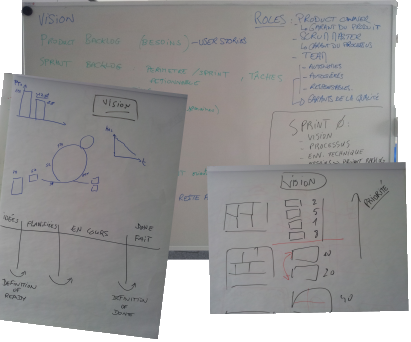Be Agile
Comment lancer votre premier projet Scrum? [Anglais]
31 Juil 2019
par
Sylvain Chery
In Agile Partner we help clients to understand the fundamentals of the Scrum framework and to get ready to start their first agile project. Our clients have various experiences and levels of exposure to Scrum, and some have no practical experience in a Scrum project. In this article we will share with you our working process with our clients.

1. Common language and shared understanding
We start by co-building an overview of Scrum. At this part, Everyone contribute to design the Scrum iterative process with all its components: roles (Scrum Master, Product Owner, Team), artifacts (vision, product backlog, sprint backlog, burndown chart and product increment) and ceremonies (sprint planning meeting, daily scrum, sprint review and sprint retrospective).
Such information can be found in various references including the Scrum Guides available on scrum.org, and Scrum 101 by the Scrum Alliance.
This first sequence aimed at establishing a common background for all participants so that they all shared a common language and understanding of what Scrum is.
2. Get ready to start
Then we focused on what needs to be prepared prior to starting a Scrum project and for maximizing the chance of success. That is what is usually called the "Sprint 0", which allows setting up key aspects of the project, in particular:
- Project vision
- Process elements (sprint duration, time and place of the daily standup, definition of ready and definition of done, etc…)
- Technical environment
- Initial product backlog
- Stakeholders' roles and responsibilities
As a consulting practice we pay a particular attention to this preliminary phase, because when an organisation is launching a pilot project to experiment Scrum it is usually only a few weeks long and there are usually a limited number of opportunities for improvement during the project. Thus it is essential to invest in the Sprint 0 for paving the way to success.
One element that is often overlooked is the Product Vision. Though we cannot over-emphasize how important it is actually to clarify and share the Vision for the product to be built. Why should this product be built? How will it make a difference? What impact should it have and how can we measure it? So many things can be adapted during the course of the project but the team needs a clear Vision to guide its decisions.
3. Critical areas of concern
Finally we discuss with our clients about their two main areas of concern when preparing to start their Scrum projet: the Product Owner and Product Backlog.
Each of these could be the topic of an entire seminar on its own, however based on our experience, we stressed the following ideas to take away from this session:
About the Product Owner:
- The Product Owner must be appointed with full authority to define the Product Vision and manage its Product Backlog;
- Product Owner is a role, which encompasses a number of responsibilities, but in short she/he is responsible for the Product;
- In the ideal case the Product Owner is also an individual, but in reality there are many situations when it is not a single person;
- When several persons share the responsibilities of the Product Owner, there must be one person who has the authority to arbitrate between competing product areas and conflicting priorities.
About the Product Backlog:
- The Product Backlog is a highly dynamic artefact;
- To be actionnable, the Product Backlog must be both prioritized and estimated;
- It is built with the principles of "just-in-time" and "just-enough" requirements in order to avoid waste;
- The granularity of Product Backlog items depends on their respective priority;
- The effort spent in estimating Product Backlog items should decrease with their priority;
- User Story is a common and useful format but not necessarily the only one for Product Backlog items.
Additional resources about the Product Backlog can be found in the Scrum Alliance Resource Center as well as the Guide to Agile Practices (Agile Alliance).
In our agile trainings and workshops, we also integrate practical exercises to co-create an initial product backlog from a given product vision. Our sessions are filled with a strong interaction between participants to answer questions and exchanges views. After all it's more important to adapt and answer the customer's real needs rather than follow an initial plan. That's what Agile is all about!

